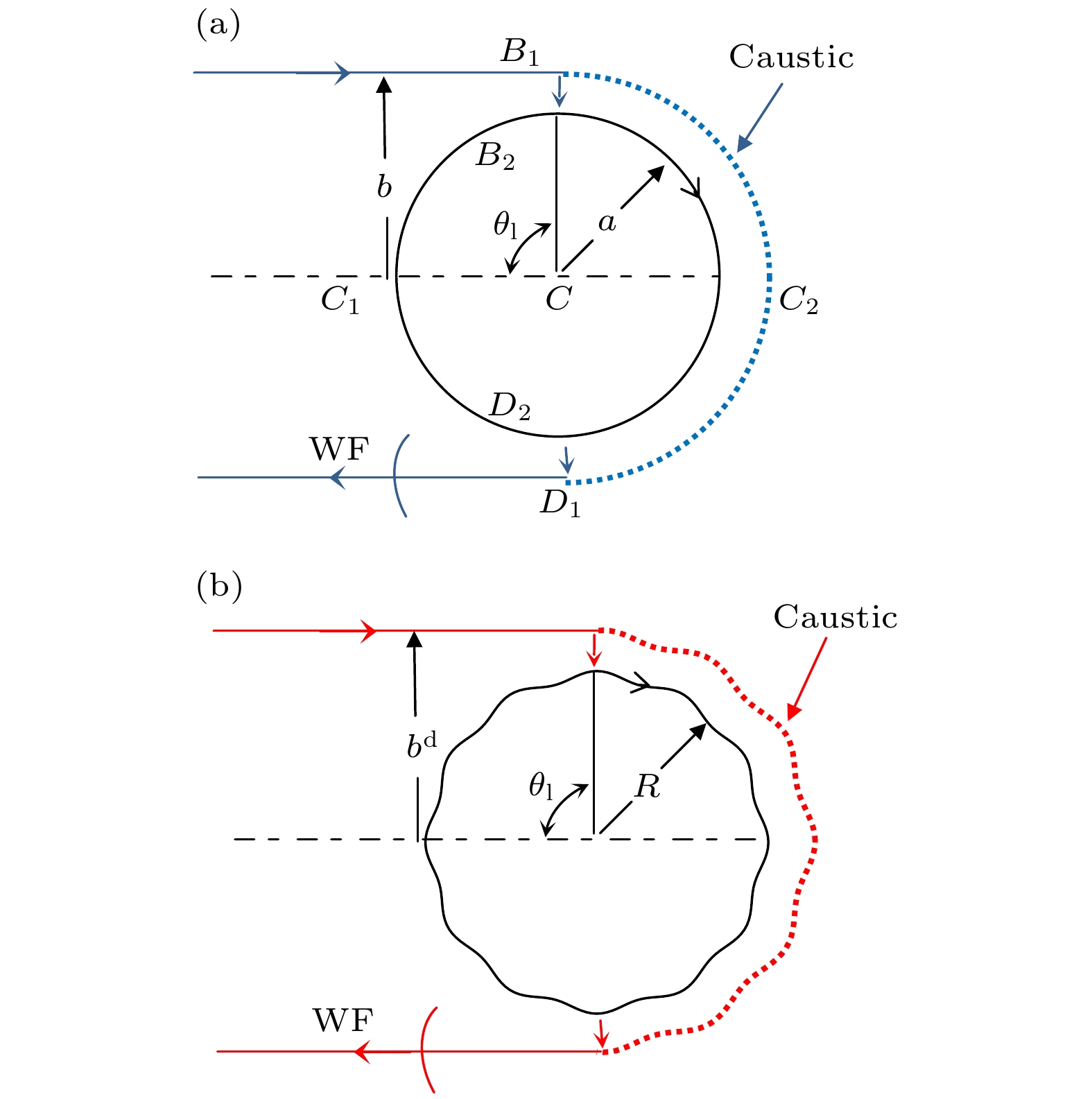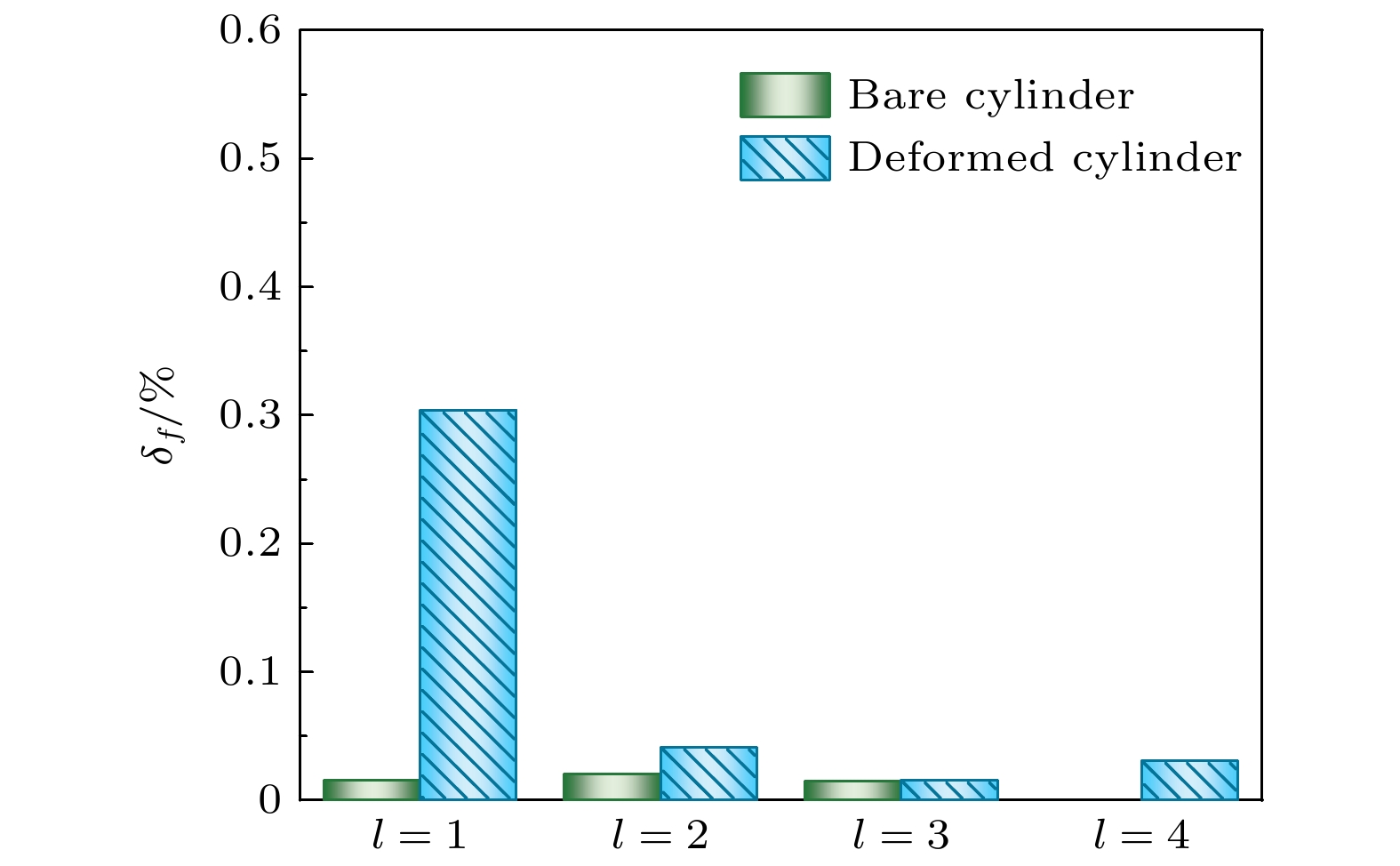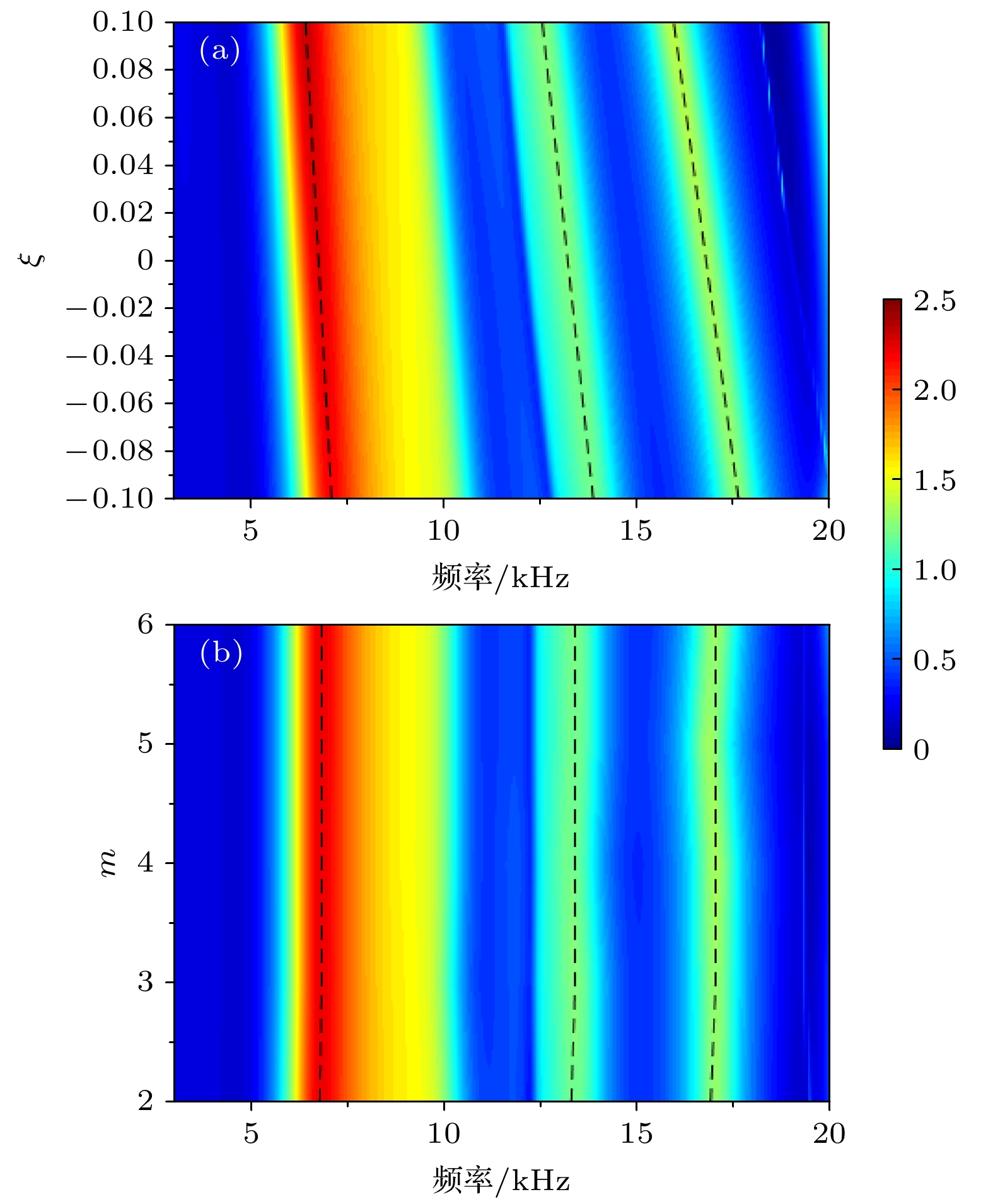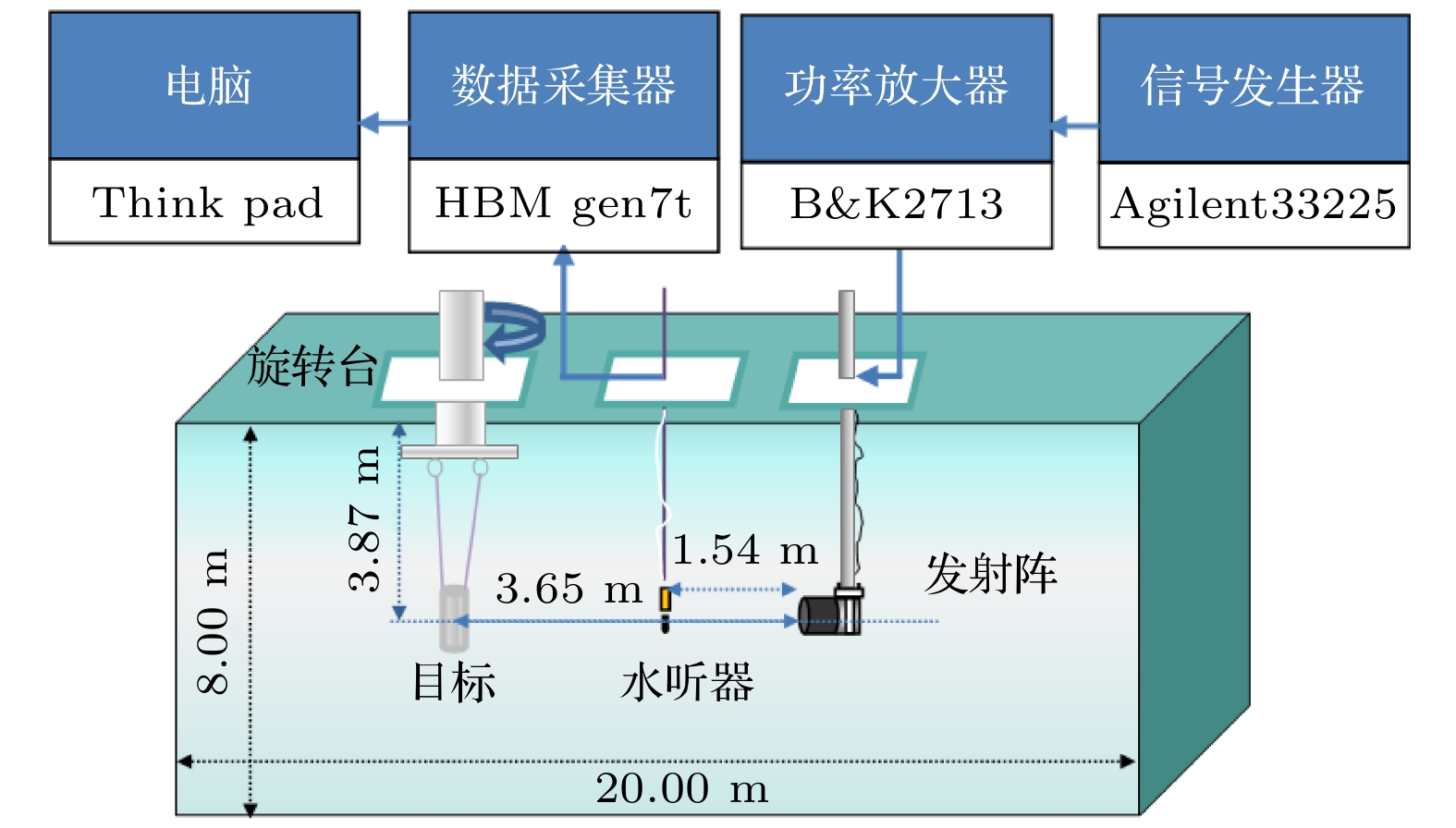-
塑料类高分子材料甲基丙烯酸甲酯-亚克力(PMMA)圆柱中亚音速Rayleigh波低频隧穿共振可引起反向散射增强, 在低频标准散射体设计等领域具有重要应用价值. 提出一种微弱形变的规则波纹表面结构, 可实现水中PMMA圆柱反向散射低频共振频率的无源调控. 利用微扰法推导了水中微弱形变规则波纹圆柱反向散射低频共振频率偏移的近似解, 讨论了波纹微扰系数、周期对规则波纹圆柱共振频率偏移的影响规律. 基于Rayleigh波相位匹配方法分析了低频共振频率偏移的机理. 研究表明: 微弱形变规则波纹圆柱中亚音速Rayleigh波沿微弱形变波纹表面传播, 与光滑圆柱体相比, 传播路径的改变引起Rayleigh波传播相位变化, 导致了Rayleigh波低频共振频率发生偏移. 最后开展了微弱形变规则波纹圆柱体声散射特性水池实验, 获取了其反向散射共振频率, 明显观察到了规则波纹圆柱共振频率偏移现象, 与理论预报结果吻合较好.
-
关键词:
- 规则波纹 /
- 圆柱 /
- 亚音速Rayleigh波 /
- 共振散射
Backscattering enhancement associated with subsonic Rayleigh wave resonance of a polymethlmethacrylate (PMMA) cylinder is observed at low frequencies in water, which suggests that the PMMA cylinders may have essential applications in the low-frequency standard scatterer design. A slightly deformed surface structure with regular corrugation is presented to manipulate the low-frequency backscattering resonance frequency of PMMA cylinder passively. Using the perturbation method, the approximate resonance frequency shift is derived for an infinite slightly deformed cylinder with regular corrugations. Based on the phase matching of Rayleigh waves, the mechanism of low-frequency resonance frequency shift is revealed. Studies show that compared with a bare cylinder, a small boundary deformation can cause the propagation path of Rayleigh waves to change, namely, the Rayleigh waves propagate along the slightly deformed surface with regular corrugations. The modified propagation path can cause the propagation phase to change, which brings about the low-frequency backscattering resonance frequency shift of a PMMA cylinder. Furthermore, how the resonance frequency shifts with the deformation coefficient and period of the corrugation is discussed in detail. The backscattering resonance frequency of the regular corrugated cylinder shifts to low frequency with the increase of ξ under the condition of the deformation coefficient ξ > 0, but shifts to high frequency with the decrease of ξ at ξ < 0, and the resonance frequency shift increases with the increase of absolute value of deformation coefficient. When corrugation period m < 10, the phase variation with m is too small, so the corrugation period has little effect on the resonance frequency shift. Finally, acoustic scattering experiment of the regular corrugated cylinder is conducted in the tank. The resonance frequency shift is obviously observed in the experiment, which is in good agreement with the theoretical prediction. Hence, the characteristics of backscattering enhancement associated with subsonic Rayleigh wave and the resonance frequency shifts make the PMMA deformed cylinder have potential applications such as in standard scatter design and identification using “AcoustiCode”.-
Keywords:
- regular corrugation /
- cylinder /
- subsonic Rayleigh wave /
- resonance scattering
[1] Ge L, Song Q H, Redding B, Eberspacher A, Wiersig J, Cao H 2013 Phys. Rev. A. 88 043801
 Google Scholar
Google Scholar
[2] Ge L, Song Q H, Redding B, Cao H 2013 H Phys. Rev. A. 87 023833.1
 Google Scholar
Google Scholar
[3] Fawcett J A 2016 IEEE J. Ocean. Eng. 41 682
 Google Scholar
Google Scholar
[4] Zhang L G, Sun N H, Marston P L 1992 J. Acoust. Soc. Am. 91 1862
 Google Scholar
Google Scholar
[5] Fawcett J A 2001 J. Acoust. Soc. Am. 109 1312
 Google Scholar
Google Scholar
[6] Guel-Tapia J A, Villa-Villa F, Mendoza-Suarez A, Perez-Aguilar H 2016 Archives of Acoustics 41 461
 Google Scholar
Google Scholar
[7] Hartmann B, Jarzynski B 1974 J. Acoust. Soc. Am. 56 1469
 Google Scholar
Google Scholar
[8] Hefner B T, Marston P L 2000 J. Acoust. Soc. Am. 107 1930
 Google Scholar
Google Scholar
[9] Satish A, Trivett D, Sabra K G 2020 J. Acoust. Soc. Am. 147 EL517
 Google Scholar
Google Scholar
[10] Srivastava P, Nichols B, Sabra K G 2017 J. Acoust. Soc. Am. 142 EL573
 Google Scholar
Google Scholar
[11] Doolittle R D, Überall H, Uginčius P 1968 J. Acoust. Soc. Am. 43 1
 Google Scholar
Google Scholar
[12] Dubertrand R, Bogomolny E, Djellali N, Lebental M, Schmit C 2008 Phys. Rev. A. 77 013804.1
 Google Scholar
Google Scholar
[13] Donald B, Gaunaurd G C 1983 J. Acoust. Soc. Am. 73 1448
 Google Scholar
Google Scholar
[14] 龙云亮, 文希理, 谢处方 1994 数值计算与计算机应用 2 88
 Google Scholar
Google Scholar
You Y L, Wen X L, Xie C F 1994 Journal on Numerical Methods and Computer Applications 2 88
 Google Scholar
Google Scholar
[15] 汤渭霖 1995 声学学报 06 456
 Google Scholar
Google Scholar
Tang W L 1995 ACTA. ACUSTICA. 06 456
 Google Scholar
Google Scholar
[16] Marston P L, Sun N H 1995 J. Acoust. Soc. Am. 97 777
 Google Scholar
Google Scholar
[17] 周彦玲, 范军, 王斌 2019 物理学报 68 214301
 Google Scholar
Google Scholar
Zhou Y L, Fan J, Wang B 2019 Acta Phys. Sin. 68 214301
 Google Scholar
Google Scholar
[18] 汤渭霖, 范军, 马忠诚 著 2018 水中目标声散射 (北京: 科学出版社) 第99—104页
Tang W L, Fan J, Ma Z C 2018 Acoustic Scattering of Underwater Targets (Beijing: Science Press) pp99–104 (in Chinese)
[19] 彭茜蕤, 周彦玲, 范军 2018 声学技术 37 528
Peng X R, Zhou Y L, Fan J 2018 Technical Acoustics 37 528
[20] 程建春 著 2019 声学原理 (北京: 科学出版社) 第615—619页
Cheng J C 2019 Acoustical Principle (Beijing: Science Press) pp615–619 (in Chinese)
-
表 1 计算所用材料参数
Table 1. Material parameters used in the calculations.
材料 密度/(kg·m–3) 纵波波速/(m·s–1) 剪切波波速/(m·s–1) PMMA 1190 2690 1340 水 1000 1500 — 表 2 无限长PMMA圆柱和规则波纹圆柱共振频率
Table 2. Resonance frequency of PMMA bare and corrugated cylinder
l ${f_0}$/Hz $f_0^{\prime}$/Hz ${f_\xi }$ /Hz $f_\xi^{\prime}$/Hz 1 6419 6420 6259 6240 2 9953 9955 9704 9700 3 13383 13385 13048 13050 4 16790 16790 16370 16375 表 3 实验模型共振峰频率
Table 3. Resonance frequencies of experimental objects.
l ${f_0}$/Hz ${f_{\xi_ 1} }$/Hz $f_{\xi_1} ^{\prime}$ /Hz ${f_{\xi_ 2} }$/Hz $f_{\xi_ 2}^{\prime}$/Hz 1 6649 6748.7 6852 6981.4 6966 2 8643 8772.6 9098 9075.1 9294 3 12410 12596.0 12996 13031.0 13192 -
[1] Ge L, Song Q H, Redding B, Eberspacher A, Wiersig J, Cao H 2013 Phys. Rev. A. 88 043801
 Google Scholar
Google Scholar
[2] Ge L, Song Q H, Redding B, Cao H 2013 H Phys. Rev. A. 87 023833.1
 Google Scholar
Google Scholar
[3] Fawcett J A 2016 IEEE J. Ocean. Eng. 41 682
 Google Scholar
Google Scholar
[4] Zhang L G, Sun N H, Marston P L 1992 J. Acoust. Soc. Am. 91 1862
 Google Scholar
Google Scholar
[5] Fawcett J A 2001 J. Acoust. Soc. Am. 109 1312
 Google Scholar
Google Scholar
[6] Guel-Tapia J A, Villa-Villa F, Mendoza-Suarez A, Perez-Aguilar H 2016 Archives of Acoustics 41 461
 Google Scholar
Google Scholar
[7] Hartmann B, Jarzynski B 1974 J. Acoust. Soc. Am. 56 1469
 Google Scholar
Google Scholar
[8] Hefner B T, Marston P L 2000 J. Acoust. Soc. Am. 107 1930
 Google Scholar
Google Scholar
[9] Satish A, Trivett D, Sabra K G 2020 J. Acoust. Soc. Am. 147 EL517
 Google Scholar
Google Scholar
[10] Srivastava P, Nichols B, Sabra K G 2017 J. Acoust. Soc. Am. 142 EL573
 Google Scholar
Google Scholar
[11] Doolittle R D, Überall H, Uginčius P 1968 J. Acoust. Soc. Am. 43 1
 Google Scholar
Google Scholar
[12] Dubertrand R, Bogomolny E, Djellali N, Lebental M, Schmit C 2008 Phys. Rev. A. 77 013804.1
 Google Scholar
Google Scholar
[13] Donald B, Gaunaurd G C 1983 J. Acoust. Soc. Am. 73 1448
 Google Scholar
Google Scholar
[14] 龙云亮, 文希理, 谢处方 1994 数值计算与计算机应用 2 88
 Google Scholar
Google Scholar
You Y L, Wen X L, Xie C F 1994 Journal on Numerical Methods and Computer Applications 2 88
 Google Scholar
Google Scholar
[15] 汤渭霖 1995 声学学报 06 456
 Google Scholar
Google Scholar
Tang W L 1995 ACTA. ACUSTICA. 06 456
 Google Scholar
Google Scholar
[16] Marston P L, Sun N H 1995 J. Acoust. Soc. Am. 97 777
 Google Scholar
Google Scholar
[17] 周彦玲, 范军, 王斌 2019 物理学报 68 214301
 Google Scholar
Google Scholar
Zhou Y L, Fan J, Wang B 2019 Acta Phys. Sin. 68 214301
 Google Scholar
Google Scholar
[18] 汤渭霖, 范军, 马忠诚 著 2018 水中目标声散射 (北京: 科学出版社) 第99—104页
Tang W L, Fan J, Ma Z C 2018 Acoustic Scattering of Underwater Targets (Beijing: Science Press) pp99–104 (in Chinese)
[19] 彭茜蕤, 周彦玲, 范军 2018 声学技术 37 528
Peng X R, Zhou Y L, Fan J 2018 Technical Acoustics 37 528
[20] 程建春 著 2019 声学原理 (北京: 科学出版社) 第615—619页
Cheng J C 2019 Acoustical Principle (Beijing: Science Press) pp615–619 (in Chinese)
计量
- 文章访问数: 7246
- PDF下载量: 77
- 被引次数: 0














 下载:
下载:















